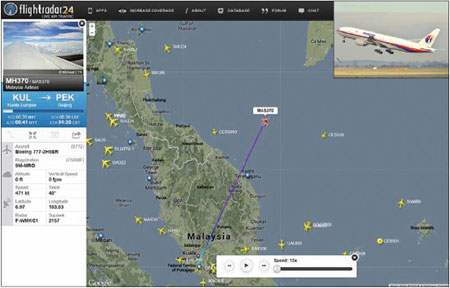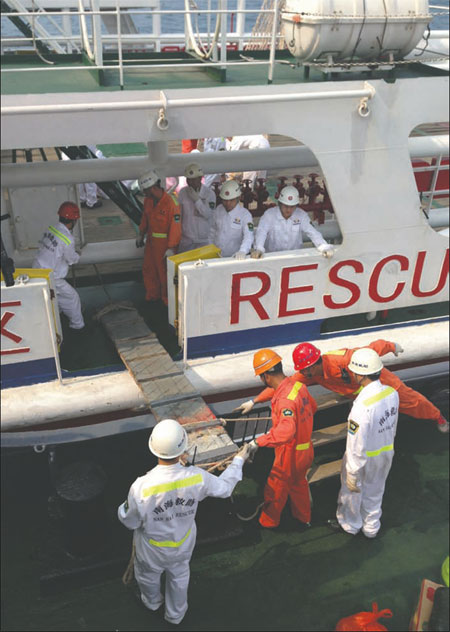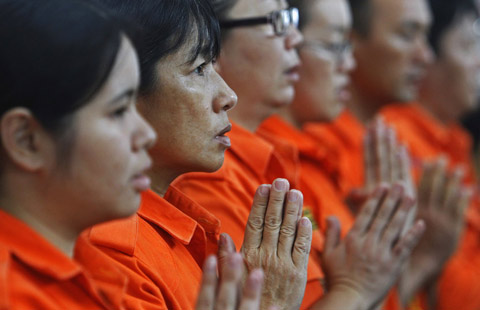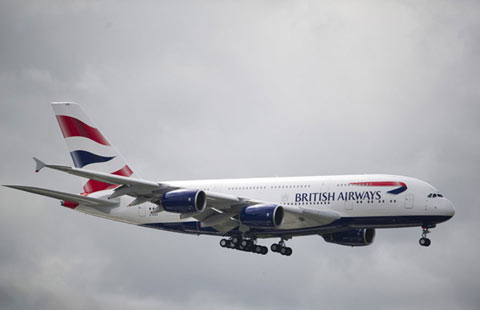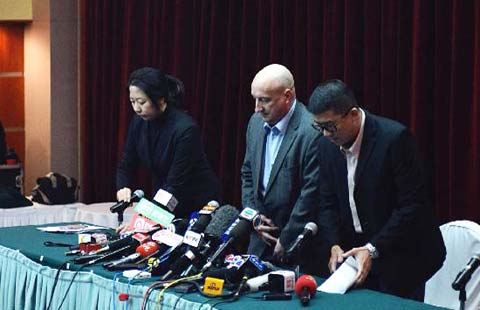Search widens for lost air carrier
Updated: 2014-03-10 12:04
By Zhang Lei and He Na in Beijing and Jack Freifelder in New York (China Daily USA)
|
||||||||
According to the Malaysian government, two Asians used the stolen passports to board the missing Malaysia Airlines Flight MH 370, Xinhua reported as search and rescue teams from across Southeast Asia joined in the massive international sea search Monday morning.
On Sunday night, President Xi Jinping and US President Barack Obama talked about the missing airplane over the phone.
The world continued ask: What happened to MH 370?
The Beijing-bound Boeing 777 left Kuala Lumpur in the early hours of Saturday morning with 239 people aboard, including 154 Chinese nationals, and was supposed to arrive at its destination at 6:30 am, but vanished from radar screens somewhere between the east coast of Malaysia and southern Vietnam.
"The answer may not come in the days or weeks ahead - maybe not even the months ahead - but right now all hands are on deck just trying to get some clues," Brian Foley, president of Brian Foley Associates, an aviation advisory firm, said on Sunday in an interview with China Daily.
"One of the top priorities now is just locating the machine," Foley added.
Late Sunday search and rescue workers said they might have discovered some wreckage from airliner, according to Xinhua News Agency which quoted Vietnamese sources as saying a military patrol boat had found "suspicious floating yellow objects" 80 kilometers from the Tho Chu Islands in the Gulf of Thailand.
Earlier on Sunday, the scope of the search for the lost aircraft was widened to 10,000 square kilometers on Sunday after reports that the Beijing-bound jet had turned back to Kuala Lumpur before disappearing from radar screens.
Freescale Semiconductors, an Austin, Texas-based embedded hardware producer, announced on Sunday that 20 of its employees were confirmed passengers on Malaysia Airlines Flight MH370.
"At present, we are solely focused on our employees and their families," said Gregg Lowe, president and CEO of Freescale, in a March 8 press announcement. "Our thoughts and prayers are with those affected by this tragic event."
Freescale - which designs semiconductors chips and microprocessors - said that among the 20 aforementioned employees on flight MH370, 12 are from Malaysia and eight are from China.
Malaysian officials said at a media briefing on Sunday that radar signals indicated the jet had altered course and may have been heading back toward the Malaysian capital when it disappeared. Datuk Azharuddin Abdul Rahman, director-general of Malaysia's Department of Civil Aviation, said the reports had prompted the expansion of the search area to include the west coast of Malaysia.
Also on Sunday, an oil slick was spotted around 80 km southwest of two slicks spotted earlier by Vietnamese Air Force planes. The original slicks, said to be consistent with a crashed aircraft, were later reported to have disappeared.
Chinese rescue ship Taishunyuan failed to find any evidence of debris at the suspected crash site on Sunday morning.
Nine countries, including the US, Singapore and Vietnam, have joined the search.
Interpol confirmed on Sunday that at least two stolen passports - an Austrian and an Italian - were used by passengers on the flight.
The passports were stolen in Thailand in 2012 and 2013, Interpol said. The agency is trying to determine the identities of the passengers who used the stolen passports.
"Whilst it is too soon to speculate about any connection between these stolen passports and the missing plane, it is clearly of great concern that any passenger was able to board an international flight using a stolen passport," said Interpol Secretary General Ronald K. Noble.
In Beijing, the families of the missing passengers were awaiting developments at the Lido Hotel on Sunday. They were being looked after by around 100 Malaysia Airlines staff members.
Speaking at the National People's Congress on Sunday afternoon, Premier Li Keqiang said he was receiving regular updates on developments in the search and rescue operation from relevant departments. "We are doing everything we can. The government not only has to ensure the safety of citizens at home, but must also provide strong support for outbound travelers," he said.
Floyd Wisner, an aviation crash attorney with Chicago-based Wisner Law Firm, said in an email to China Daily: "it is much too early to speculate about the cause of this Malaysian Airlines crash, but crashes into the ocean, unlike crashes on approach or departure, usually involve, at least in part, some type of mechanical or aircraft system problem or failure."
The water temperature is relatively warm on the surface of the South China Sea, so if any passengers survived the presumed crash, they may have been granted a slightly longer survival period, he said.
Huang Huikang, China's ambassador to Malaysia, said the unusual loss of contact was still a puzzle.
The missing Malaysian jet may have turned back from its scheduled course to Beijing before disappearing, a military official said here Sunday.
He attended an internal meeting of Malaysian authorities and was told that in the event of a failure of the electronic systems or engines, the aircraft would still have been able to send out a distress signal and even if the signal system crashed, electronic positioning sensors would still function.
The FBI sent agents and technical experts to assist in the inquiries. US officials told the Los Angeles Times that they were trying to determine if there was any link with terrorist activity, but stressed that no evidence had yet been found to support that theory.
"Just because they (the passports) were stolen doesn't mean the travelers were terrorists," according to an official from the US Department of Homeland Security, interviewed by the newspaper. "They may have been nothing more than thieves. Or they could have simply bought the passports on the black market," he added.
The two passengers were caught on closed-circuit television at Kuala Lumpur International Airport, and the footage would be studied closely as part of the investigation, said Datuk Azharuddin Abdul Rahman.
Although the possibility of finding survivors is slim, the search and rescue teams have spared no efforts. China dispatched naval vessels, the frigate Mianyang and the amphibious landing ship Jinggangshan, according to PLA navy sources. Mianyang was expected to reach the search area by 7:30 am on Monday, while Jinggangshan is scheduled to arrive by 10 am Tuesday.
Jinggangshan sailed from Zhanjiang port in South China's Guangdong province at 3 am on Sunday. In addition to 14 medical professionals and 10 rescue divers, the ship was carrying life-saving equipment, underwater detection monitors and supplies of oil, water and food. It is also equipped with two helicopters, speedboats and 52 marines.
Mianyang was on a mission in the waters close to the Nansha Islands in the South China Sea before being dispatched to the search and rescue zone at 11:50 pm on Saturday. Wu Shengli, commander-in-chief of the PLA navy, responded quickly to the news of the lost plane and ordered the South China Sea Fleet to prepare for the rescue mission.
Zhao Yifei, professor of Air Traffic Management Institute at the Civil Aviation University of China, said taking off and landing are two most dangerous parts of any flight. The chances of a fatal incident occurring when the aircraft is at cruising altitude are remote.
"In my experience, among all the possible causes of an aircraft going missing or crashing, I think only one thing is certain - whatever happened occurred so quickly that it left the pilots with no time to place a distress call," said Zhao.
Zhao suggested that the aircraft might have broken up in mid-air, or a loss of control may have sent it plunging it the ocean intact. "I think the possibility that the aircraft is already deep in the water is also quite high. The rescue workers may find some floating debris and seats, but the larger parts of the aircraft may take longer to find," he said.
Gao Yuanyang, director of the General Aviation Industry Research Center at Beihang University in Beijing, said that although the aircraft had been in service for about 12 years, that didn't mean it was old and prone to technical problems.
"It's very likely that the plane broke up in mid-air. That would explain the sudden loss of contact. When contingencies such as heavy thunderstorms happen, the captain will usually activate the rescue system, and have time to contact the air traffic control tower or the airspace management department, therefore something extremely unexpected must have happened to this plane, and all further analysis depends on locating the exact point where it went down," he said.
However, according to Mei Dongmu, an aircraft designer at the Aviation Industry Corporation of China, adverse weather was unlikely to be the cause of the plane's disappearance. "It's quite common for a plane to be caught in turbulence, something that's essentially unpredictable. And in the overwhelming majority of cases, the pilot, after sensing the instability in the plane's movement, would simply get out of harm's way by gaining altitude or bypassing the center of the turbulence," he said.
"But of course there are rare occasions when due to a number of reasons - the pilots taking scheduled sleep breaks, for example - the threat of bad weather is noticed too late, and the plane, out of control, plunges headlong toward the ground, or, as has been speculated in this instance, the ocean," he added.
Unlike Zhao, Mei believed the plane should have been easy to find. "If it did indeed plunge into the ocean, then it would be almost impossible for us not to find it. It's a common misconception that a crashed plane is bound to sink to the bottom of the sea - in reality, the cylindrical fuselage would almost certainly float on the surface of the water for some time, even if it had broken into two or three sections," he said. "And all the other stuff - chairs, cushions, plastic bags, for example - would eventually form a little island of wreckage carried by the waves. We have found nothing like that so far," he said.
"So, in my view, the plane didn't fall into the ocean or onto the ground. It simply exploded mid-air, the metal shell breaking into a million pieces that can no longer be identified. The bodies of the victims have probably fallen into the ocean, and it might take days for them to resurface," he said. "I know it's the bleakest picture possible and something we are all very reluctant to believe, but it's my honest opinion," he said.
Mei offered two possible reasons for an explosion. "One is metal fatigue: The plane has been in service for 12 years and may have needed an overhaul at Boeing's headquarters in the United States. I'm not sure about the condition and the maintenance of the aircraft, but there's a possibility that it had been overused, which could have led to an explosion," he said. "It's very much like hammering a piece of reinforced glass that has that kind of 'fatigue' - the glass just cracks into powder. If a plane reaches that state, almost anything could prove to be the last straw."
The other possible reason is terrorism. "If terrorists had detonated dynamite on the plane, it would just explode and vanish," he said.
Captain John M. Cox, CEO of Safety Operating Systems, was a pilot for US Airways for 25 years. He said that whatever happened to the Malaysia Airlines jet, it happened quickly. The problem had to be big enough to stop the plane's transponder from broadcasting its location, although the transponder can be deliberately closed down from the cockpit, he said.
One of the first indicators of what happened will be the radius of the field of debris. If it is large and spread over a wide area, the plane probably broke apart at high altitude, which may indicate a bomb or a massive failure of the airframe. If the debris field is limited, the plane was probably intact and fell from 10,000-plus meters before breaking up on contact with the water.
"We know the airplane is down. Beyond that, we don't know a whole lot," Cox said.
Contact the writers at zhanglei@chinadaily.com.cn and hena@chinadaily.com.cn and jackfreifelder@chinadailyusa.com
Zhao Xu, Hou Liqiang, Xu Wei, Wang Wen, Zhao Shengnan, Zhao Yinan, Cui Jia and Zhang Yan contributed to this story.
Timeline of the Chinese authorities' response
Saturday
In the morning, the Ministry of Transport dispatches two rescue vessels to the South China Sea to help in the search and rescue operation for Malaysia Airlines' flight MH370, which has lost contact with air traffic control.
At a media briefing on the sidelines of the National People's Congress, Foreign Minister Wang Yi says China is concerned about the Beijing-bound Boeing 777-200 and says the ministry and related departments have activated emergency response mechanisms.
President Xi Jinping orders emergency measures over the missing plane. He instructs the Foreign Ministry and Chinese embassies and consulates to maintain contact other countries and pay close attention to the search and rescue operation. Xi says all-out efforts must be made to provide emergency treatment in the aftermath of the incident.
In the afternoon, Premier Li Keqiang makes an urgent call to the Malaysian Prime Minister Najib Razak. Li asks Malaysia and related countries to work together to locate the missing aircraft as quickly as possible and to do everything possible to launch rescue missions.
Also that afternoon, Vice-Foreign Minister Xie Hangsheng meets with Bala Chandran Tharman, the Malaysian charge d'affaires to China, and Nguyen Van Tho, the Vietnamese ambassador to China.
Minister of Transport Yang Chuantang announces the launch of the highest-level emergency response mechanism. Eight ships belonging to the Nanhai Rescue Bureau and the Hainan Maritime Safety Administration await orders. A fleet of aircraft fleet also prepares to take off.
Sunday
An emergency response team is assembled by the Ministry of Transport. Early in the morning, the team sets out from Sanya in the southern province of Hainan and heads to the waters where it's thought the missing plane may have crashed.
|
Above: This screengrab from flightradar24.com shows the last reported position of Malaysian Airlines flight MH370, Friday night March 7. The Boeing 777-200 carrying 239 people lost contact over the South China Sea on a flight from Kuala Lumpur to Beijing, and international aviation authorities still hadn't located the jetliner some 50 hours later. Flightradar24.com / AP |
|
Malaysia Airlines Commercial Director Hugh Dunleavy speaks to journalists about missing Malaysia Airlines Flight MH370 at a hotel in Beijing on Sunday. Jason Lee / Reuters |
|
Rescue workers on board a Chinese vessel in Sanya, Hainan province, on Sunday, as it prepared to depart and assist with the search for the missing Malaysia Airlines' Boeing 777-200. Zhao Yingquan / Xinhua |
|
Rosmah Mansor (left), the wife of Malaysian Prime Minister Najib Razak, meets family members of passengers on flight MH370 in Kuala Lumpur. Reuters |
(China Daily USA 03/10/2014 page1)
Most Viewed
Editor's Picks

|

|

|

|

|

|
Today's Top News
China goes all-out to search for missing flight
Families of missing jet passengers arrive in Kuala Laumpur
Beijing calls for dialogue on Ukraine
Thai travel agents questioned over tickets for missing jet
Questions abound as the mystery deepens
Search widens for lost air carrier Boeing 777
Carrying out goals of report vital
GDP target of 7.5% possible
US Weekly

|

|
